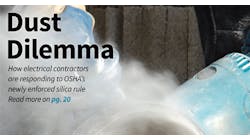New NEC requirements make it important to understand the difference between surge protectors, surge arresters, and transient voltage surge suppressors
The term “surge protector” can describe any device that protects against surges, which are excess voltages — either impulses or sustained AC overvoltages. If you work in an area that receives a lot of lightning or where electric utility power is unreliable, installing surge protectors will greatly reduce damage to equipment in both commercial and residential buildings. The NEC allows, but doesn't require you to install AC surge protection.
Surge protectors can so effectively limit lightning damage that in certain areas like Orlando, Fla., the local authorities go beyond NEC requirements and require the installation of AC protectors for all new construction. One way to obtain this protection is by using panelboards that incorporate factory-installed surge protectors.
Underwriters Laboratories (UL) has two categories for testing and Listing hard-wired AC surge protectors. The older category, surge arrester (SA) (Category OWHX), originally included protectors hard-wired at the service entrance, or at any location downstream from the service disconnect.
The newer category, transient voltage surge suppressor (TVSS), covered in UL 1449 Second Edition, includes both hard-wired, permanently connected protectors and plug-in AC power protectors, which are frequently called surge strips. The hard-wired and plug-in protectors were tested to different standards. Either type can include integrated signal protectors for CATV, phone, or other signal connections. These are frequently called multi-port protectors. Hard-wired SAs and TVSSs can be installed indoors or outdoors, depending on the manufacturer's stated application information supported by UL environmental testing.
The 2002 NEC was changed to restrict the application of these devices. Now only protectors with the SA rating are allowed to be installed before the service disconnect [Art. 280 and 230.82(3)]. Only TVSSs may be installed after the disconnect (Art. 285). Dual-Listed devices, approved under both standards, may be installed in any location. Additionally, 285.6 of the NEC requires TVSSs to be marked with their short-circuit (fault) current rating. The UL TVSS standard has been modified to add this requirement to test procedures and marking, but the SA standard hasn't yet been changed.
Additionally, the UL standard 96A for lightning protection systems requires that an SA be installed at the AC service entrance to protect the wiring and electrical equipment in the building.
The Figure shows possible locations for hard-wired protectors and the corresponding UL and NEC requirements.
Why do the categories overlap? What test standards apply to them? The reasons are, to a great extent, historical. The Table shows the critical withstand tests with the most difficult requirements for the different protector categories. The UL standards include several additional requirements, but those in the Table are key to the damaging conditions surge protectors are not only exposed to in operation, but must also protect against.
The Table shows reasons for some of the restrictions. The harshest environment is at the service equipment. Only an SA must withstand the 10kA test pulse without incurring damage. That's why the SA rating is required at the service entrance.
The hard-wired TVSS is exposed to much smaller lightning surges. It's downstream from the service entrance so a lower surge withstand is required. The plug-in TVSS, protected by a branch circuit breaker and building wiring, has an even lower surge requirement.
All TVSS products may be used in proximity to people inside the building. Experience shows that significant exposure to severe AC overloads can result from power cross brought about by accidental contact between high-voltage and 120V circuits, from utility problems, and when electricians work on live wiring, so all TVSS products must survive or fail safely under severe overload. A special test is available for determining whether TVSS devices will survive or fail safely in the event of an open neutral in split-phase or 3-phase circuits. Such an event could expose the protector to two times or 1.73 times the nominal phase voltage, with limited low or moderate current. Although this might seem unlikely, open neutral problems are the most common cause of power quality events. A low fault current had the potential to cause smoldering without tripping circuit breakers and lead to fires in some situations before the new UL 1449 Standard required TVSS products to be protected against limited-current AC overvoltage.
Finally, SAs may not be installed downstream from the service entrance because they haven't been tested for interrupt rating or other sustained AC overvoltage events.
What protection can you expect from SA and TVSS hard-wired protectors? If properly installed, they'll limit incoming AC surges, even from nearby lightning strikes, to voltages from several hundred volts to about 2,000V, depending on the size of the incoming surge, the protector itself, and the lead length between the panel and the protector. Without the protector, the generally accepted threat levels from incoming lightning strikes are limited by flashover of meter spark gaps at 6kV to 10kV, and breakdown of wiring devices at roughly 6kV for interior wiring.
Not much has been published about the surge voltage withstand of equipment and appliances. For telecom equipment, the former FCC Part 68 required that equipment withstand 2,500V short line-to-neutral impulses.
A study of appliances conducted several years ago by Northeast Utilities showed that none was damaged by 1,000V short line-to-neutral impulses. Recent international standards, including EN 55104, require line-to-neutral surge withstand of 1,000V for the standard “combination wave,” which is 50µs long as a voltage testing wave. So it's reasonable to assume that plug-in 120VAC equipment can probably withstand 1,000V impulses, although more delicate equipment may be damaged at this level. A substantial amount is probably safe against 2,000V impulses, but it's tough to say which part.
Comparing these surge withstand levels with the protection levels listed above suggests that a good hard-wired protector, properly installed, should provide good protection for most plug-connected equipment, for small and moderate lightning strikes. Hard-wired protectors should also protect hard-wired HVAC and motor-driven appliances.
Standard hard-wired panel protectors won't provide useful protection for equipment in three situations:
-
An open neutral conductor or other sustained AC overvoltage.
-
If the equipment has signal connections (CATV, phone line, data line, or control wiring) in addition to the AC power.
-
If the equipment is unusually sensitive to AC impulses.
For all these situations, full protection can be provided by proper multi-port plug-in surge protectors, which have lower AC limiting voltage than the hard-wired protectors and have additional protection circuits to limit surges coming in on signal lines.
Cohen is vice president of new technology, Panamax, Petaluma, Calif.


